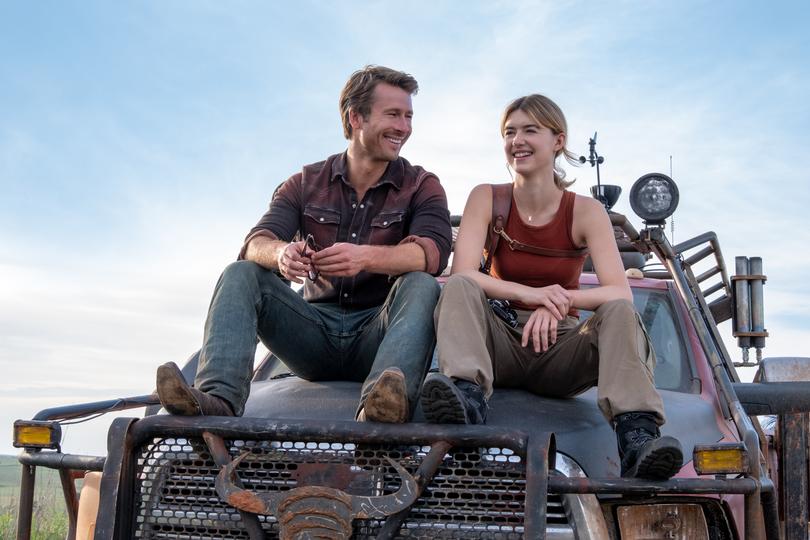Twisters: Glen Powell, Daisy Edgar-Jones, Anthony Ramos and Lee Isaac Chung on the sequel’s bold ambitions

If you rewatch the 1996 movie Twister, the special effects are definitely of the era. Though the terrifying tunnels of wind looks a little scrappy now, in its day, it was revolutionary enough to be nominated for an Oscar.
But the action felt real. When Helen Hunt and Bill Paxton’s characters are running for their lives at the end of the film, thrown about by that insane wind as everything around them is sucked up, it still induces white knuckles.
Perhaps that’s why Twister remains the most memorable of the wave of 1990s disaster flicks that also included Dante’s Peak, Volcano, Deep Impact and Armageddon. Well, Armageddon also sticks in the cultural consciousness, but more for that Aerosmith song — and also for all the eye rolls.
Sign up to The Nightly's newsletters.
Get the first look at the digital newspaper, curated daily stories and breaking headlines delivered to your inbox.
By continuing you agree to our Terms and Privacy Policy.Which makes any follow-up, even 28 years later, slightly risky. Sure, you have the advantage of more advanced technology, but how do you deliver the combination of thrills and heart?
What you do is hire Lee Isaac Chung, the twice Oscar-nominated filmmaker of Minari, a quiet, emotional and deeply personal story of the immigrant experience in 1980s America.
An indie filmmaker coming off the back of a sensational semi-biographical drama isn’t the most obvious choice for Twisters, a $US200 million blockbuster. But it was the correct one — for both Twisters and Chung.

“Minari was so personal, but it was also a painful movie to make,” Chung told The Nightly. “It’s not an easy story and after I had done that, I just felt like everything that was in my heart, that side of myself, I put it on the table.
“I really wanted to run to something that I felt would enliven me and make me feel new thrills about filmmaking.”
Chung had always wanted to make action and adventure movies, the type Amblin, Steven Spielberg’s production company, was famed for. In between Minari and Twisters, Chung had a bridge — he directed an episode of Star Wars show The Mandalorian.
But it was still hard to convince producers that he was the guy because it’s always hard. “I’d feel a little bored if I were just leaning into something that other people knew I could do. If I were doing that, it would feel like I’m just taking it easy in some sense. I wanted to go for the thing that would be really hard and challenging,” he said.
Twisters is set in the same universe as the original. While none of the 1996 characters appear or are mentioned, there is a direct callback — the “field-tested” data-collecting device Dorothy VI has a role.
Here, the main character is Kate (Daisy Edgar-Jones), a meteorologist and Oklahoman native who went through a traumatic and tragic experience and now works at a desk in New York City. Thanks to an increase in tornado events (ahem, climate change, ahem), Kate is convinced by former friend Javi (Anthony Ramos) to return for one week as a storm-chaser.

On the road, she meets Tyler (Glen Powell), a bombastic YouTuber who calls himself the Tornado Wrangler. In the grand tradition of the original film and almost every workplace rom-com, Kate and Tyler’s early conflict is clearly going to lead somewhere.
Powell said it’s the human story that makes Twisters distinct from every other blockbuster. “What’s so exciting about (Chung) is that so often, the bigger a movie gets, the less intimate or emotional it gets. When you see Minari, it’s so elegantly directed, it’s teeming with emotion and authenticity.
“That’s really the key to Twisters. (Chung) really fought to shoot this in Oklahoma for it to be authentic, for us to be surrounded by real people during storm season. And that’s what you get with a top-tier filmmaker like him, somebody who’s used to telling the truth on film.
“You get something really special. That’s why I think this movie really sings with something different. It doesn’t feel like a movie that’s just a big movie for the sake of being big. It’s big and it beats with a heart. That’s rare.”
Shooting in Oklahoma during storm season brought advantages and challenges. On the one hand, the landscapes were amazing, especially the open skies and clouds. But the skies were usually harbingers of something destructive.

“That’s basically what happened throughout production,” Chung recalled. “The skies are going to look great, we’re going to be happy for 30 minutes and then we’re going to have to run away.”
The day Chung shot the film’s opening harrowing opening sequence, after the crew quickly packed up, an actual tornado came through.
Edgar-Jones found weather-watching was almost a religion in Oklahoma, which, as a Brit, she found useful. “I think storms and storm season is such a part of the culture and everyone is kind of a meteorologist in a way. They all know how to read radars and understand cloud movement, it was really amazing.”
Being part of that environment really informed the vibes of the film. When you’re in it, it translates on the screen. And at least they had the locals to look to about when to panic, and when to just get on with your day.
“I was having dinner with (Chung) on my first day, just to go to do a costume fitting and read through the script, and the windows started rattling,” Ramos recalled.
“And I’m asking the waiter, I’m like, ‘Yo, my man, is that good? Is that normal? Are we good? Should we go to our rooms?’ and he’s like, ‘Nah. You want still or sparkling?’.
“They don’t even flinch. It’s just a way of life out there.”

